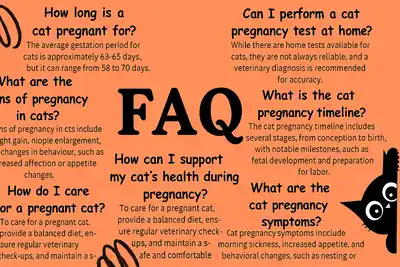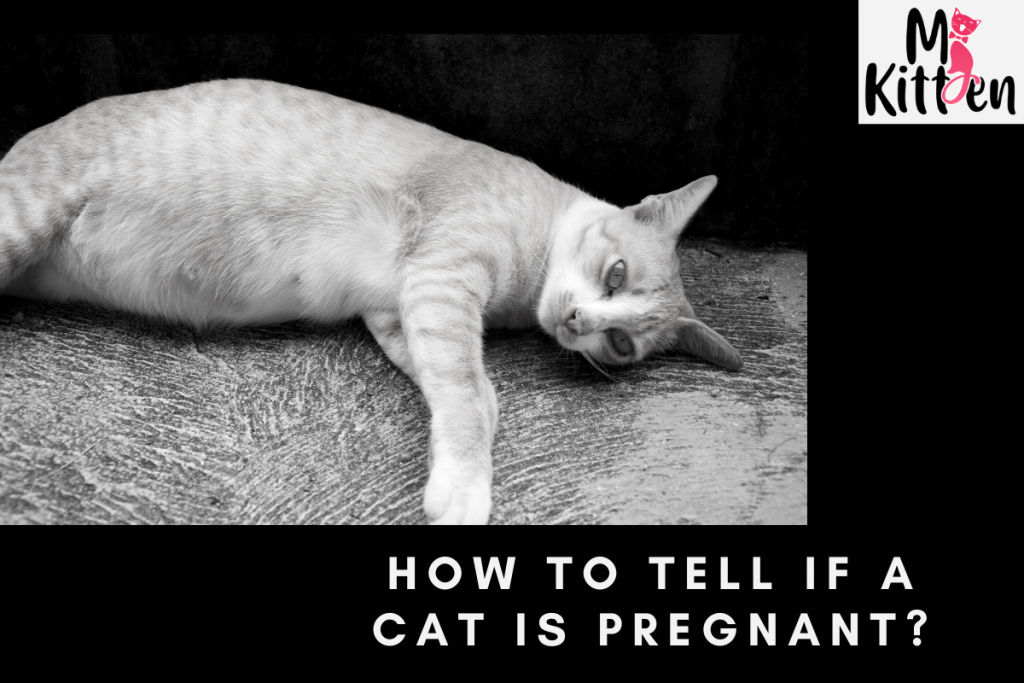Is Your Cat Pregnant? Here's How to Tell
Is Your Cat Pregnant? Recognize the Signs of Feline Pregnancy
Did you know that an unspayed female cat can become pregnant as early as 4-6 months of age? This surprising fact highlights the importance of understanding the signs of pregnancy in cats. If you’re a cat owner, it’s crucial to recognize the indicators of pregnancy to provide the necessary care and attention.
Determining whether your cat is pregnant involves observing physical and behavioral changes. Some common signs include changes in appetite, weight gain, and nesting behavior. Recognizing these signs early on can help you prepare for the arrival of new kittens and ensure a healthy pregnancy.
Understanding the signs of cat pregnancy is vital for providing the best possible care. In this article, we’ll explore the key indicators of feline pregnancy and what you can do to support your cat during this critical period.
How to Tell If Your Cat Is Expecting: Signs and Symptom
Understanding Cat Pregnancy Basics
Understanding the fundamentals of cat pregnancy is crucial for cat owners. Cat pregnancy, also known as gestation, typically lasts around 63 to 65 days, but it can vary depending on several factors.
The average gestation period for cats is approximately 9 weeks. Factors such as breed, litter size, and the health of the mother can influence the duration of the pregnancy. For instance, some breeds may have a slightly longer or shorter gestation period.
A cat’s pregnancy is divided into several stages, each with distinct characteristics. Knowing the cat pregnancy timeline helps owners anticipate and prepare for the arrival of the kittens. During the initial stages, symptoms might not be apparent, but as the pregnancy progresses, physical and behavioral changes become more noticeable.
Cat pregnancy symptoms can include weight gain, nipple enlargement, and a swollen abdomen. As the due date approaches, owners should be prepared to provide a safe and comfortable environment for their cat to give birth.
Although spaying and neutering cats are necessary as it will reduce the risk of multiple pregnancies as cats have this tendency from when they are kittens themselves. Spraying and neutering also reduce the chance of getting sick easily. The neutering eliminates the production of hormones that cause an uncastrated male to roam and spray urine for marking territory outside and inside the owner’s home. A female kitten should be spayed prior to her first heat which is around 4 months of their age. If you find trouble figuring out the pregnancy yourself, then you must consult with our professionals to have a general examination. Before you schedule the visit to the vet try reading on our guidelines to determine if kittens are on the way.
Cats can conceive easily and can give birth just nine weeks after conception, seems like they don’t waste any time family planning for the future. But as their owner, it is your foremost responsibility to plan their health for their benefits.
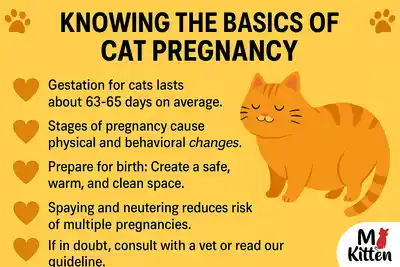
How To Tell If A Cat Is Pregnant? Physical Signs
If you suspect your cat is pregnant, there are several physical signs you can look for to confirm your suspicions. One of the earliest signs is a change in the color and size of her nipples.
Around three weeks into pregnancy, your cat’s nipples may become more pronounced and change to a deeper pink color, a phenomenon often referred to as “pinking.” This is one of the earliest visible signs that your cat is expecting.
Another physical indicator is weight gain. Pregnant cats typically gain weight gradually over the course of their pregnancy. By around four to five weeks, this weight gain becomes more noticeable, particularly in the abdominal area.
A pregnant cat’s abdomen will begin to swell as the pregnancy advances. By the fifth week, the swelling is usually quite noticeable. You may be able to feel the kittens moving if you gently palpate your cat’s abdomen, though this should be done with care to avoid causing discomfort.
Other Visible Signs
In addition to nipple changes and weight gain, there are other physical signs to look out for. Some cats may exhibit a decrease in physical activity as the pregnancy progresses, while others may continue to be active until later in their pregnancy.
In the later stages of pregnancy, your cat may start to look more rounded, and her belly may appear to be dropping as the kittens move into position for birth. Understanding these signs can help you better care for your cat during this period.
Recognizing the signs of pregnancy in cats is crucial for providing the appropriate care and ensuring a healthy outcome for both the mother and her kittens. By being aware of these physical changes, you can better understand what your cat is going through and prepare for the arrival of the new kittens.
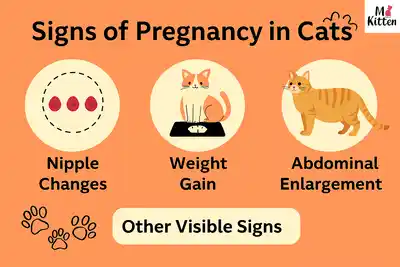
Behavioral Changes in Pregnant Cats
As your cat’s pregnancy progresses, you may notice significant changes in her behavior. These changes can be indicative of her needs during this period. Understanding these behavioral changes is crucial for providing the necessary care and support.
One of the primary changes observed in pregnant cats is a shift in their appetite. Some cats may eat more than usual, while others may experience a decrease in appetite. It’s essential to monitor your cat’s food intake to ensure she is receiving the necessary nutrients for a healthy pregnancy.
Pregnant cats often become more affectionate and demanding of attention. They may also exhibit changes in their activity levels, becoming either more lethargic or restless. Providing a comfortable and quiet space for your cat to rest is vital.
In terms of caring for a pregnant cat, it’s crucial to maintain a balanced diet and ensure regular veterinary check-ups. Your veterinarian can provide guidance on the best food for your cat during pregnancy and monitor the health of both the mother and the kittens.
Additionally, creating a safe and comfortable environment for your cat is essential. This includes providing a warm, quiet place for her to give birth and ensuring that she has easy access to food, water, and litter facilities.
By understanding and responding to the behavioral changes in your pregnant cat, you can help ensure a healthy and successful pregnancy. This includes being attentive to her needs, providing a nurturing environment, and seeking professional advice when needed.
Caring for a pregnant cat requires attention to detail and a commitment to providing the best possible care. By doing so, you can help ensure the health and well-being of both your cat and her kittens.
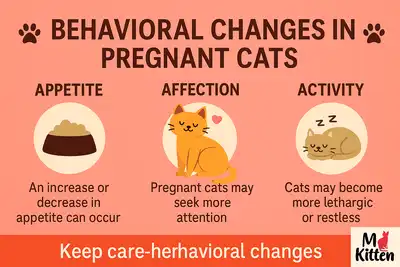
Confirming Your Cat's Pregnancy
Confirming your cat’s pregnancy is a crucial step in ensuring her health and the health of her kittens. Several methods can be used to determine if your cat is pregnant, and the choice of method often depends on the stage of pregnancy.
Early detection is key to providing proper care. One of the earliest methods is palpation, which involves feeling the abdomen for fetuses.
Palpation Technique
Palpation is a non invasive technique that can be performed by a veterinarian between 17 to 25 days into pregnancy. It requires skill, as the veterinarian needs to gently feel the cat’s abdomen to detect the fetuses.
Ultrasound and X-ray Options
An ultrasound can detect pregnancy as early as 15-17 days and is a safe, non-invasive method. X-rays, on the other hand, are typically used later in pregnancy (around 45 days) to count the number of kittens and assess their size and position.
Blood tests measure the level of certain hormones associated with pregnancy. While not as commonly used for cats as for humans, they can provide valuable information in certain cases.
Understanding these methods helps cat owners make informed decisions about their cat’s care. Consulting a veterinarian is essential to determine the best method for confirming pregnancy and ensuring the health of both the mother and the kittens.
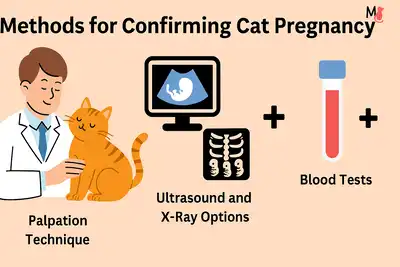
Caring for Your Pregnant Cat
A pregnant cat needs proper care to ensure the health of both the mother and the kittens. Proper nutrition is vital during this period.
Providing a balanced diet rich in essential nutrients is crucial. Pregnant cats require more calories and proteins to support the growth of the kittens. It’s advisable to feed high-quality cat food that is rich in protein and calcium.
Exercise is also an important aspect of caring for a pregnant cat. Gentle play and moderate exercise can help maintain the cat’s physical health. However, it’s essential to avoid strenuous activities that could cause stress or injury.
Regular health checks are vital to monitor the cat’s health and the development of the kittens. Consult with a veterinarian to schedule prenatal check-ups and follow their advice on caring for your pregnant cat.
By focusing on proper nutrition, appropriate exercise, and regular health checks, you can help ensure a healthy pregnancy for your cat. This not only benefits the mother but also supports the development of healthy kittens.
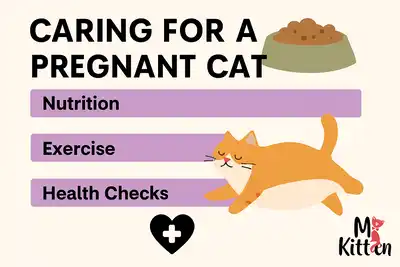
Relatable Signs of pregnancy are
Soon after conception or in the 1st and 2nd weeks, your cat would not show any signs of pregnancy. But in the 3rd week, things become a little more noticeable. After that period, you will notice that your cat will no longer go into heat, and her body will begin to change. The common change will be a swollen body, pink nipples, and a larger abdomen. Some other signs may be increased appetite and vomiting like that of a human. Pregnant felines often need more of your time as they become more affectionate than usual.
Visit your veterinarian
Visit a vet after you realize any of the above-mentioned symptoms is present in your cat. Make sure to confirm the pregnancy and know if your cat is healthy and progressing normally. Our professional’s advice to not try pressing the cat’s belly or lift them without their approval, as it might hurt the kittens and cause miscarriage. The vet might confirm the pregnancy with an ultrasound. Please make sure you provide medications to your cat as directed by the vet.
The delivery
Your cat will try to nest before she gives birth, it means setting up a place to have her litter. The cat will try to relax in your closet more than often. Try not to take out your cat outside during this time and provide your cat with a nesting box with a large cupboard, include a towel or blanket, and place the box in an area of your home that is safe and is not bright. Provide enough food and water throughout her pregnancy. Once your cat goes into labor, she might meow loudly and vomit. Don’t. Most births go smoothly, but if any problems arise be sure to contact our vet.
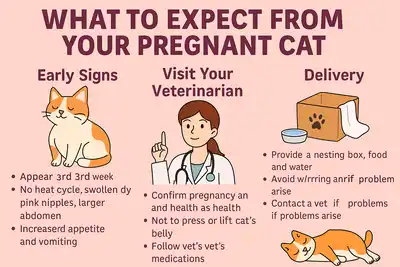
Conclusion
Understanding the duration of cat pregnancy is crucial for providing the best care. Typically, a cat is pregnant for around 63-65 days. Knowing the cat pregnancy timeline helps cat owners prepare for the arrival of new kittens.
By recognizing the physical and behavioral signs of pregnancy, cat owners can ensure their pet receives proper care and attention throughout the pregnancy period. Regular veterinary check-ups are vital to monitor the health of both the mother and the developing kittens.
As the due date approaches, cat owners should be prepared to provide a safe and comfortable environment for their cat to give birth. By being informed and prepared, cat owners can help ensure a healthy and successful outcome for their cat’s pregnancy.
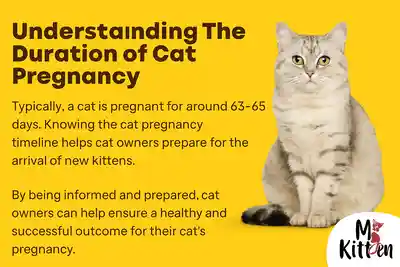
FAQ
How long is a cat pregnant for?
What are the signs of pregnancy in cats?
How can I confirm my cat’s pregnancy?
How do I care for a pregnant cat?
What are the cat pregnancy symptoms?
Can I perform a cat pregnancy test at home?
What is the cat pregnancy timeline?
How can I support my cat’s health during pregnancy?
